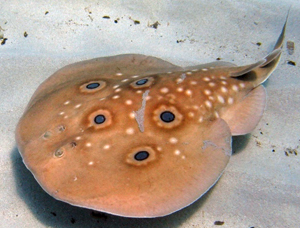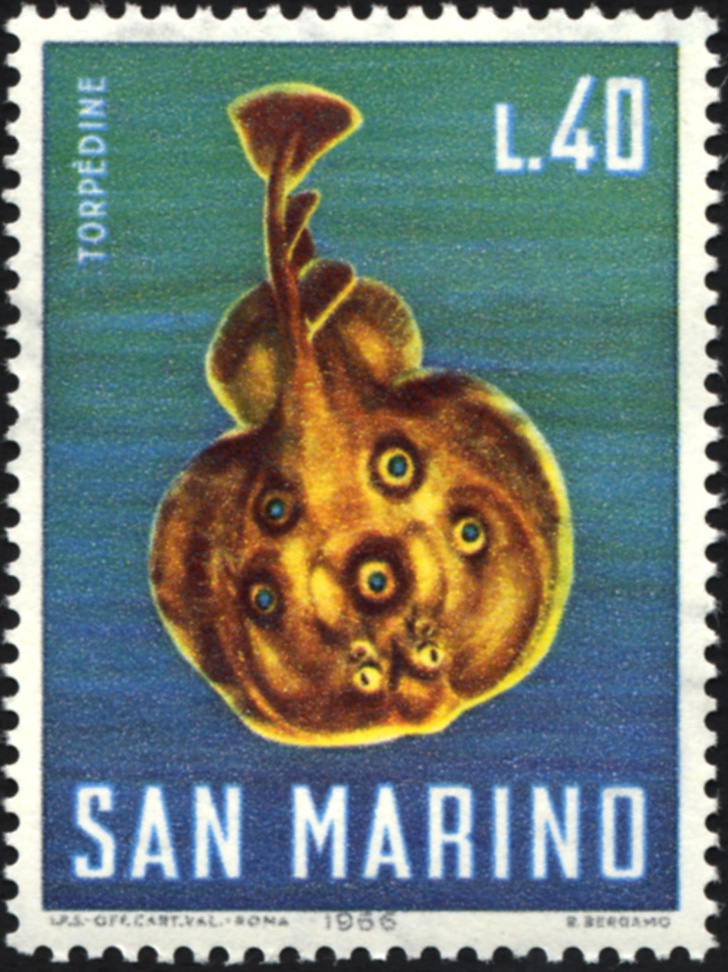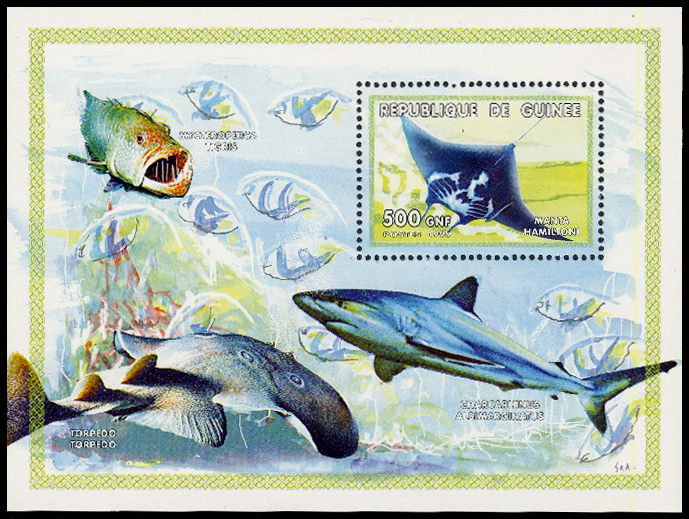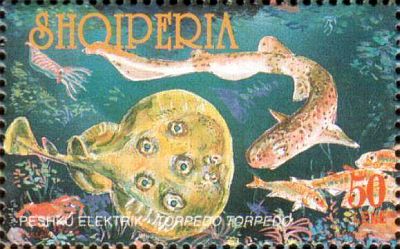Torpedo torpedo Linnaeus, 1758

(Da: it.wikipedia.org)
Phylum: Chordata Haeckel, 1874
Subphylum: Vertebrata Lamarck J-B., 1801
Classe: Chondrichthyes Huxley, 1880
Ordine: Torpediniformes de Buen F., 1926
Famiglia: Torpedinidae Bonaparte, 1832
Genere: Torpedo Houttuyn, 1764
Italiano: Torpedine ocellata
English: Eyed electric r
Français: Torpille ocellée
Deutsch: Gefleckter Zitterrochen
Descrizione
Come tutti i torpediniformi, hanno forma appiattita e sono caratterizzati dalla presenza, ai lati del corpo, di un particolare organo definito organo elettrogeno in grado di produrre scariche elettriche sensibili anche per l'uomo. Gli organi deputati alla produzione di questa particolare forma di energia animale sono due, disposti uno per parte a lato del tronco, nella sua porzione anteriore, e derivano dalla trasformazione di muscoli. La scarica va dalla superficie ventrale verso quella dorsale, negativa la prima e positiva la seconda. Può raggiungere i 60 cm e ha carni scadenti.
Diffusione
La Torpedine ocellata vive sui fondi sabbio-fangosi fra i 5 e i 100 m di profondità, nel Mediterraneo e nell'Atlantico orientale.
Sinonimi
= Raja torpedo Linnaeus, 1758 = Torpedo narke Delaroche, 1809 = Torpedo ocellata Rafinesque, 1810 = Torpedo oculata Davy, 1834 = Torpedo unimaculata Risso, 1810.
Bibliografia
–Jabado, R.W., Chartrain, E., De Bruyne, G., Derrick, D., Dia, M., Diop, M., Doherty, P., El Vally, Y., Meissa, B., Metcalfe, K., Pacoureau, N., Seidu, I., Soares, A.-L., Tamo, A., VanderWright, W.J. & Williams, A.B. (2021). "Torpedo torpedo". The IUCN Red List of Threatened Species. IUCN. 2021.
–Reebs, S. (2001). Fish Behavior in the Aquarium and in the Wild. Cornell University Press. P. 61.
–Manser, M.H.; Turton, N.D. (1998). Advanced Learners' Dictionary. Wordsworth Editions. P. 760.
–Torpedo, Raja Archived 2014-03-04 at the Wayback Machine in: Eschmeyer, W.N.; Fricke, R., eds. Catalog of Fishes electronic version (29 March 2011).
–Torpedo Archived 2012-03-19 at the Wayback Machine in: Eschmeyer, W.N.; Fricke, R., eds. Catalog of Fishes electronic version (29 March 2011).
–Fowler, H.W. (1911). "Notes on batoid fishes". Proceedings of the Academy of Natural Sciences of Philadelphia. 62 (2): 468-475.
–Froese, Rainer; Pauly, Daniel (eds.) (2011). "Torpedo torpedo" in FishBase.
–Michael, S.W. (1993). Reef Sharks & Rays of the World. Sea Challengers. P. 78.
–Wheeler, A.; du Heaume, V. (1964). "Notes on the distribution of electric rays (Torpedo spp.) in northern European waters" (PDF). Journal of the Marine Biological Association of the United Kingdom. 44 (2): 389-395.
–Lythgoe, J.; Lythgoe, G. (1991). Fishes of the Sea: The North Atlantic and Mediterranean. Cambridge, Massachusetts: MIT Press. P. 32.
–Bigelow, H.B.; Schroeder, W.C. (1953). Fishes of the Western North Atlantic, Part 2. Sears Foundation for Marine Research, Yale University. Pp. 80-96.
–Capapé, C.; Guélorget, O.; Vergne, Y.; Quignard, J. (2006). "An unusual nine-ocellated common torpedo, Torpedo torpedo (Linnaeus, 1758) (Chondrichthyes: Torpedinidae), from southern France". Acta Adriatica. 47 (1): 73-78.
–Brahim, B.R.; Seck, A.A.; Capapé, C. (1998). "Albinism in a common torpedo, Torpedo (Torpedo) torpedo". Cybium. 22 (1): 83-86.
–Capapé, C.; Seck, A.A.; Diatta, Y. (2000). "Reproductive biology of the common torpedo, Torpedo torpedo (Linnaeus, 1758) (Pisces, Torpedinidae) from the coast of Senegal (Eastern Tropical Atlantic)". Miscellania Zoologica. 23 (1): 9-21.
–Gotch, F. (1900). "The physiology of electric organs". Schafer's Textbook of Physiology (2): 561-591.
–Michaelson, D.M.; Sternberg, D.; Fishelson, L. (1979). "Observations on feeding, growth and electric discharge of newborn Torpedo ocellata (Chondrichthyes, Batoidei)". Journal of Fish Biology. 15 (2): 159-163.
–Radii-Weiss, T.; Kovacevic, N. (1970). "Influence of low temperature on the discharge mechanism of the electric fish Torpedo marmorata and T. ocellata". Marine Biology Berlin. 5: 18-21.
–Abdel-Aziz, S.H. (1994). "Observations on the biology of the common torpedo (Torpedo torpedo), Linnaeus, 1758) and marbled electric ray (Torpedo marmorata), Risso, 1810) from Egyptian Mediterranean waters". Australian Journal of Marine and Freshwater Research. 45 (4): 693-704.
–Romanelli, M.; Consalvo, I.; Vacchi, M.; Finoia, M.G. (2006). "Diet of Torpedo torpedo and Torpedo marmorata in a coastal area of Central Western Italy (Mediterranean Sea)" (PDF). Marine Life. 16: 21-30.
–Sène, A.; Bâ, C.T.; Marchand, B. (1999). "Ultrastructure of spermiogenesis of Phyllobothrium lactuca (Cestoda, Tetraphyllidea, Phyllobothriidae)". Folia Parasitologica. 6: 191-198.
–Llewellyn, J. (1960). "Amphibdellid (monogenean) parasites of electric rays (Torpedinidae)" (PDF). Journal of the Marine Biological Association of the United Kingdom. 39 (3): 561-589.
–Tazerouti, F.; Neifar, L.; Euzet, L. (2006). "Nouveaux Amphibdellatidae (Platyhelminthes, Monogenea, Monopisthocotylea) parasites des Torpedinidae (Pisces, Elasmobranchii) de Mediterranée". Zoosystema. 28 (3): 607-1616.
–Hamlett, W.C., ed. (1999). Sharks, Skates, and Rays: The Biology of Elasmobranch Fishes. JHU Press. P. 418.
–Consalvo, I.; Scacco, U.; Romanelli, M.; Vacchi, M. (2007). "Comparative study on the reproductive biology of Torpedo torpedo (Linnaeus, 1758) and T. marmorata (Risso, 1810) in the central Mediterranean Sea". Scientia Marina. 71 (2): 213-222.
–Halstead, B.W.; Auerbach, P.S.; Campbell, D.R. (1990). A Color Atlas of Dangerous Marine Animals. CRC Press. P. 180.
–Bullock, T.H., ed. (2005). Electroreception. Birkhäuser. P. 6.
–Sabatowski, R.; Schäfer, D.; Brunsch, H.; Radbruch, L.; Kasper, S. (2004). "Pain Treatment: A Historical Overview". Current Pharmaceutical Design. 10 (7): 701-716.

|
Stato: San Marino |
|---|

|
Data: 30/06/1998
Emissione: Ittiofauna Stato: Guinea |
|---|

|
Data: 12/09/2002
Emissione: Ittiofauna Stato: Albania Nota: Emesso in un foglietto di 6 v. diversi |
|---|